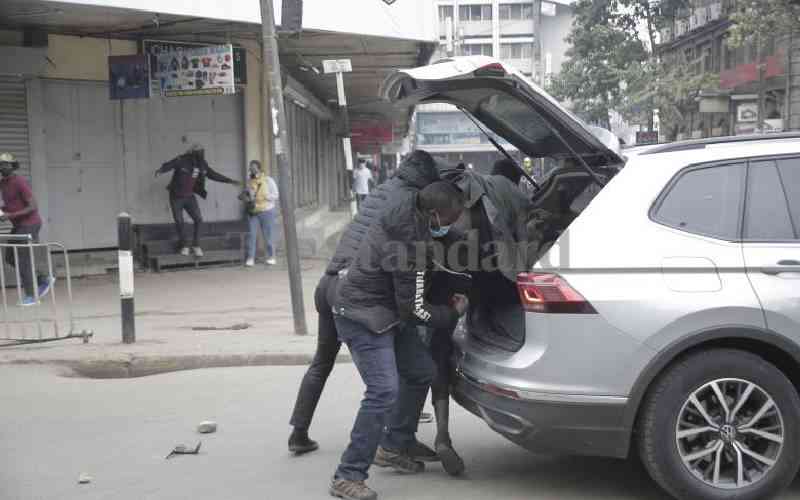By Ali Abdi
Classrooms buried by rugged sand dunes with blown off rooftops are a prominent feature in one of East Africa’s most hostile environments.
With temperatures soaring beyond 40 degrees centigrade, Chalbi Desert in North Horr could be Kenya’s only ‘true’ desert.
Its inhabitants — the Gabra, Rendille, Turkana and Dasanatch — are nomadic communities, who can withstand adverse weather conditions.
During the dry season, they contend with strong desert winds that blow rooftops and create sand dunes as temperatures rise.
In the wet season, they have to shelter from storms accompanied by lightning and floods.
Running from southern Ethiopia, the small desert is located east of Lake Turkana. North Horr constituency, now Marsabit North, is largely located in Chalbi while a small part of Laisamis (Marsabit South), like Kargi and Korr, is also affected.
North Horr trading centre is located here while Kalacha near the Ethiopian border has several oases, making it the only site with a natural source of permanent water in the vast region.
Survival for the fit
In Chalbi, only the fittest can survive. The Gabra, who keep camels, cattle and goats have devised ways to cope with the harsh desert conditions.
Herdsmen from Hurri Hills, Maikona and North Horr cross the desert in a caravan to take their animals for water at Kalacha during drought.
"I move the animals across the desert at night to the water point because the temperatures are low. I take three days before returning to the pasture area," said Galma Dido, a herdsman from North Horr .
Mr Wario Guyo, the programme officer of Pastoralists Integrated Support Programme (PISP), an NGO in Marsabit, said livestock are grazed elsewhere and taken for water at Kalacha, a tedious trip that takes days.
"Herdsmen from North Horr take three days to cross Chalbi to reach Kalacha to water animals," said Guyo.
The biggest problem in North Horr, said the official, was water, adding the NGO was among several supplementing Government efforts to provide water for the nomadic communities.
Stay informed. Subscribe to our newsletter
Since the area lacks natural sources of water, Maikona (the district headquarters), Turbi, Forolle, Burgabo and Bubisa rely on earth pans and boreholes set up by the Government and NGOs.
Rain is harvested into the pans to take residents through the dry spell, but animals often contaminate this source.
"After two months, water in the pans turn greenish, making it unfit for human consumption. The evaporation rate is also high due to high temperatures," he said.
Shoddy work
Guyo added a move to drill boreholes by the Government had failed to solve the water problems in North Horr and Laisamis and that most work was shoddy.
"The Government sunk boreholes in North Horr and Laisamis during the 2006 by-elections to woo voters. Most of them are not working today due to poor workmanship.
The water is also too salty," said Guyo. PISP came up with a new technology to harvest water through rock catchments that had been a success in Forolle, near the Ethiopian border.
"We are extending this technology to Laisamis and soon the nomads of Namurei will have a 1.3 million cubic litres of water, enough to last them during the dry season," said Guyo.
Residents reinforce their roofs and walls in centres surrounding Chalbi to guard their buildings against strong desert winds and towering sand dunes.
A school in North Horr was relocated four years ago after its classroom walls were gradually buried by sand dunes while centres like Bubisa had to be rebuilt after buildings were blown by strong winds.
"Last April, nearly all buildings in Bubisa were destroyed by strong winds. Among the affected were two primary schools and a health centre," says North Horr MP Chachu Ganya.
Harsh weather
Mr Ganya says the Government should consider the harsh weather conditions, vastness and remoteness of North Horr and split it into two.
"Population density should not be the only factor when splitting constituencies. My constituents are scattered near water points and are found in an area of more than 38,000 sq km,’’ said the MP. The constituency has a population of 70,000 and about 21,000 were registered as voters in the 2007 General Election.
However, North Horr could benefit from the strong winds and the other desert features should the Government exploit the natural resources.
Through Ewaso Ng’iro North Development Authority, the Government plans to set up a wind power plant at Bubisa to generate electricity.
There are also plans to put up a salt factory in North Horr.
"The Iran government and the African Development Bank have shown interest in helping us carry out the two projects. The power we can generate would be enough to serve northern Kenya," said the authority’s Managing Director Rashid Amin.
Energy Minister Kiraitu Muriungi said the wind energy plant at Bubisa was a priority, adding funds for the project would be sourced from Iran.
 The Standard Group Plc is a
multi-media organization with investments in media platforms spanning newspaper
print operations, television, radio broadcasting, digital and online services. The
Standard Group is recognized as a leading multi-media house in Kenya with a key
influence in matters of national and international interest.
The Standard Group Plc is a
multi-media organization with investments in media platforms spanning newspaper
print operations, television, radio broadcasting, digital and online services. The
Standard Group is recognized as a leading multi-media house in Kenya with a key
influence in matters of national and international interest.
 The Standard Group Plc is a
multi-media organization with investments in media platforms spanning newspaper
print operations, television, radio broadcasting, digital and online services. The
Standard Group is recognized as a leading multi-media house in Kenya with a key
influence in matters of national and international interest.
The Standard Group Plc is a
multi-media organization with investments in media platforms spanning newspaper
print operations, television, radio broadcasting, digital and online services. The
Standard Group is recognized as a leading multi-media house in Kenya with a key
influence in matters of national and international interest.








